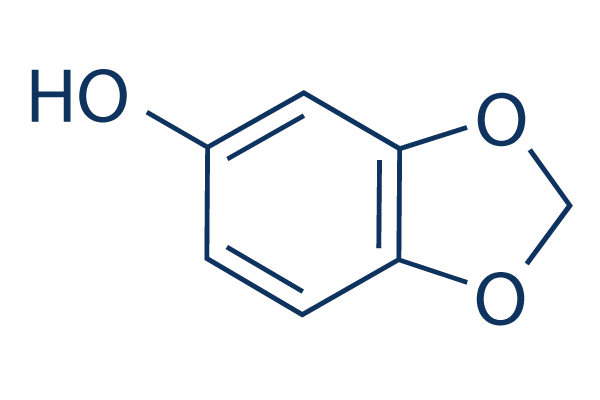|
受注:045-509-1970 |
技術サポート:[email protected] 平日9:00〜18:00 1営業日以内にご連絡を差し上げます |
化学情報

|
Synonyms | 1,3-Benzodioxol-5-ol, 3,4-Methylenedioxyphenol | Storage (From the date of receipt) |
3 years -20°C powder (seal) |
| 化学式 | C7H6O3 |
|||
| 分子量 | 138.12 | CAS No. | 533-31-3 | |
| Solubility (25°C)* | 体外 | DMSO | 27 mg/mL (195.48 mM) | |
| Water | 27 mg/mL (195.48 mM) | |||
| Ethanol | 27 mg/mL (195.48 mM) | |||
|
* <1 mg/ml means slightly soluble or insoluble. * Please note that Selleck tests the solubility of all compounds in-house, and the actual solubility may differ slightly from published values. This is normal and is due to slight batch-to-batch variations. |
||||
溶剤液(一定の濃度)を調合する
生物活性
| 製品説明 | Sesamol (1,3-Benzodioxol-5-ol, 3,4-Methylenedioxyphenol), a natural organic compound, is regarded as a major antioxidant component in the oil with chemoprevention, antimutagenic, and antihepatotoxic activities. It induces apoptosis of cancer and cardiovascular cells. |
|---|---|
| in vitro | Sesamol treatment suppresses colony formation, elicits S phase arrest during cell cycle progression, and induces both intrinsic and extrinsic apoptotic pathway in vitro with a dose-dependent manner. Furthermore, sesamol treatment elicits mitochondrial dysfunction by inducing a loss of mitochondrial membrane potential. Impaired mitochondria and accumulated H2O2 production results in disturbance of redox-sensitive signaling including Akt and MAPKs pathways. Mitochondrial biogenesis is inhibited as suggested by the decline in expression of mitochondrial complex I subunit ND1, and the upstream AMPK/PGC1α signals. Importantly, sesamol inhibits mitophagy and autophagy through impeding the PI3K Class III/Belin-1 pathway. Autophagy stimulator rapamycin reverses sesamol-induced apoptosis and mitochondrial respiration disorders[1]. Sesamol increases the activity of caspase 8, 9, and 3/7, indicating that apoptotic cell death occurred through both extrinsic and intrinsic pathways. Sesamol causes the loss of mitochondrial transmembrane potential signifying intrinsic apoptosis induction in human lung adenocarcinoma (SK-LU-1) cells[2]. |
| in vivo | Sesamol has potent anti-hepatoma activity in a xenograft nude mice model[1]. |
プロトコル(参考用のみ)
| 細胞アッセイ | 細胞株 | HepG2 cells, BRL-3A cells |
|---|---|---|
| 濃度 | 0, 0.01, 0.05, 0.1, 0.2, 0.5 or 1 mM | |
| 反応時間 | 24 h | |
| 実験の流れ | The cytotoxicity of sesamol on HepG2 cells and BRL-3A cells is examined by using MTT assay. Briefly, cells in exponential growth are seeded into 96-well plates at a density of 1 × 105 cells/mL. The cells are then treated with sesamol at various doses (0, 0.01, 0.05, 0.1, 0.2, 0.5 or 1 mM). After 24 h, the supernatant is discarded and 100 μL FBS free medium is added. 100 μL of MTT is added in each well, and cells are further incubated for 4 h in the dark. After incubation, the medium is discarded, 100 μL of DMSO is added, and the optical density of each well is measured at 570 nm. |
|
| 動物実験 | 動物モデル | Balb/c nu/nu mice |
| 投薬量 | 100 mg/kg or 200 mg/kg | |
| 投与方法 | i.p. |
参考
|
長期の保管のために-20°Cの下で製品を保ってください。
人間や獣医の診断であるか治療的な使用のためにでない。
各々の製品のための特定の保管と取扱い情報は、製品データシートの上で示されます。大部分のSelleck製品は、推薦された状況の下で安定です。製品は、推薦された保管温度と異なる温度で、時々出荷されます。長期の保管のために必要とされてそれと異なる温度で、多くの製品は、短期もので安定です。品質を維持するが、夜通しの積荷のために最も経済的な貯蔵状況を用いてあなたの送料を保存する状況の下に、製品が出荷されることを、我々は確実とします。製品の受領と同時に、製品データシートの上で貯蔵推薦に従ってください。
